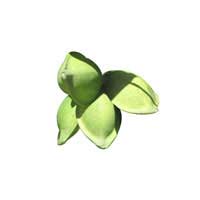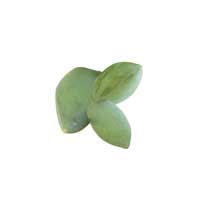 Full List of Fruits
Full List of Fruits  Indian almond
Indian almondIndian almond
Scientific name - Terminalia catappa
Known by several other common names such as Bengal almond, tropical almond, Malabar almond and country almond, Terminalia catappa is a large tropical tree from the leadwood tree family. With different male and female flowers on the same tree, the trees come under the category of monoecious. Produced on axillary or terminal spikes, both are 1 cm (0.39 in) in diameter, white to greenish, with petals that are inconspicuous.
With just about 20+ vernacular names, the tree grows to 35m- 115 ft tall. When fully ripe, the seed within the fruit can even be consumed and it tastes like almond. Coming to the fruit it bears, it is a drupe 5-7 cm (2.0-2.8 in) long and 3-5.5 cm (1.2-2.2 in) broad. The color of the fruit changes from start to end, green at first, and then yellow and finally when ripe, they are red in color and contains a single seed.
![]() Nutritional Value of Indian almond
Nutritional Value of Indian almond
| Principle | Nutrient Value | Percentage of RDA |
|---|---|---|
| Energy | 575 Kcal | 29% |
| Carbohydrates | 21.67 g | 16% |
| Protein | 21.22 g | 38% |
| Total Fat | 49.42 g | 165% |
| Cholesterol | 0 mg | 0% |
| Dietary Fiber | 12.20 g | 30% |
| Vitamins | ||
| Folates | 50 µg | 12.5% |
| Niacin | 3.385 mg | 21% |
| Pantothenic acid | 0.47 mg | 9% |
| Pyridoxine | 0.143 mg | 11% |
| Riboflavin | 1.014 mg | 78% |
| Thiamin | 0.211 mg | 16% |
| Vitamin A | 1 IU | 0% |
| Vitamin C | 0 mg | 0% |
| Vitamin E | 26 mg | 173% |
| Electrolytes | ||
| Sodium | 1 mg | 0% |
| Potassium | 705 mg | 15% |
| Minerals | ||
| Calcium | 264 mg | 26% |
| Copper | 0.996 mg | 110% |
| Iron | 3.72 mg | 46.5% |
| Magnesium | 268 mg | 67% |
| Manganese | 0.10 mg | 4% |
| Phosphorus | 9.21 mg | 1% |
| Selenium | 2.5 µg | 4.5% |
| Zinc | 3.08 mg | 28% |
| Phyto-nutrients | ||
| Carotene-ß | 1 µg | -- |
| Crypto-xanthin-ß | 0 µg | -- |
| Lutein-zeaxanthin | 1 µg | -- |
Considered as a vital foodstuff in Vanuatu, inspite of the taste being not pleasant or noteworthy, villagers consume this aromatic fleshy fruit. Tasting the Indian almonds give you a nutty taste that’s just like almonds, also it has great oil content. Taste of the fruit differs at times; sometimes they are bitter and other tomes tastes sweet. It is also said that the Filipinos make wine from this particular fruit.
With not much flavor or taste, the fruit has a pleasant aroma and the ripe outer layer of the fruit can be eaten raw. They are best when young and sweet. With almond and hazel-nut flavor, the seeds make a great snack. The oil extracted can also be used for cooking or in soap making.
Tropical almonds and fishes have a great connection; they are used by breeders of tropical aquarium fishes to keep them hale and hearty. It includes bettas, catfishes and black water tetras. Given that tropical almond has antibacterial properties, it is brilliant in this regard.
In view of the fact that, the nature of the seeds is obstinate, they have very short life, with no capacity to withstand low temperatures; they cannot be dried well as well.
The tree is best grown under the following circumstances and it includes:
![]() Well-drained soil
Well-drained soil
![]() Moist and full-sun
Moist and full-sun
![]() Planting is good in frost free areas
Planting is good in frost free areas
With many tropical trees, this is the case and tropical almonds can be grown in a container where its size can be controlled for many years.
![]() Health Benefits of Indian almond
Health Benefits of Indian almond
Leaves are used to cure skin problem.
The Seeds are helps to relieve from liver cancer.
The first step in opening and cutting an Indian almond is to remove the outer shell of the nut. This can be done by gently tapping the almond with a hammer or other hard object. Make sure to use a tool that won't damage the nut inside. Once the shell is cracked open, use a knife to carefully cut the almond in half. Be sure to cut it as evenly as possible.
The next step is to remove the kernel of the nut. This can be done by using a nutcracker or a pair of pliers. Place the nut between the crackers and firmly apply pressure to crack it open. Once the nut is cracked open, use a spoon or a small knife to pry out the kernel from the inside of the almond.
Once the kernel is removed, the next step is to cut the almond into smaller pieces. The easiest way to do this is to use a sharp knife to slice the almond into thin slices. Start by cutting the almond into four equal sections and then slicing each piece into thin strips. This will help to ensure that the almond pieces are all the same size and shape.
When cutting the almond, it is important to be careful not to damage the kernel inside. If you are not careful, the kernel will become crushed and the almond will not taste as good. When cutting the slices, make sure to cut them in a straight line and avoid making any jagged edges.
Finally, the last step is to grind the almond pieces into a powder. This can be done using a food processor or a mortar and pestle. Make sure to use a food processor that is specifically designed for grinding nuts. If you don't have one, you can also use a coffee grinder or a spice grinder.
Once the almond is ground into a powder, it is ready to be used in a variety of recipes. The powder can be used to make almond butter, almond milk, or even added to smoothies for a nutty flavor. The powder can also be used to top salads or as a topping for desserts.
In conclusion, opening and cutting an Indian almond is a straightforward process. All you need is a hammer, a knife, a nutcracker, and a food processor. With these tools and a bit of patience, you will be able to successfully open and cut your Indian almond.
To store Indian almond, it is best to store it in a cool, dry place. The nuts should be kept in an airtight container such as a glass jar or plastic bag. The nuts must be kept away from direct sunlight and moisture. If the nuts are stored in a dry environment, they can last for up to one year.
When it comes to storing the Indian almond oil, it is important to keep it in a cool, dark place. The oil should be stored in an airtight container and kept away from direct sunlight and moisture. The oil should be used within one year of purchase. If stored correctly, the oil can last for up to two years.


















